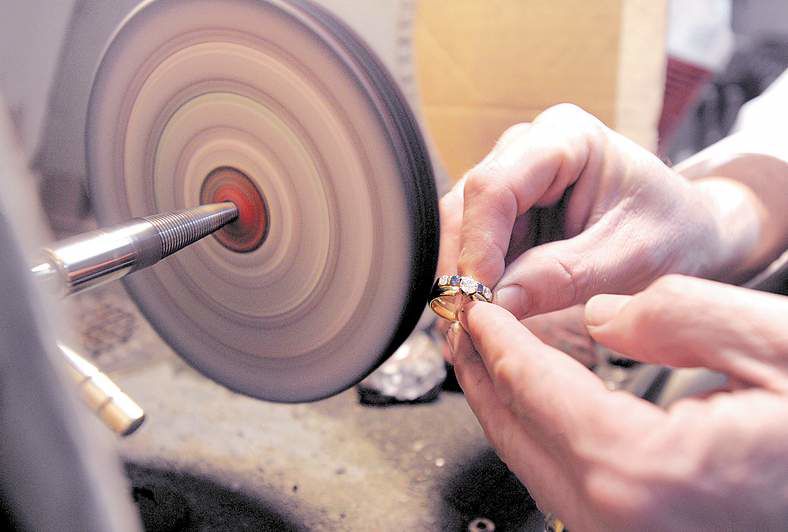How to clean jewelry
Published 5:00 am Tuesday, April 12, 2011

- Ron Henderson polishes a ring while working at Saxton's Fine Jewelers in Bend.
Spring cleaning isn’t just for houses. It’s a good time of year to spiff up your jewelry, too — from expensive gemstones and antiques, to watches and favorite pieces of inexpensive costume jewelry.
For tips and guidelines about how to clean and care for jewelry at home, we checked in with two Central Oregon jewelry experts: Ron Henderson, a partner at Saxon’s Fine Jewelers in the Old Mill District (www.saxonsfinejewelers .com), and Heather Hanst, owner of Silverado Jewelry Gallery in downtown Bend (www.silveradogallery.com).
Both said it’s important to know what you’ve got in order to know how to keep it well cared for and clean.
Understand the jewels
After you understand your jewelry’s metals and stones, some simple homemade cleaning solutions or store-bought items can help to keep them dazzling.
All you need is water, dish soap, nonsudsing ammonia, Mr. Clean liquid cleaner, baking soda, toothpaste and an old toothbrush.
Hard stones like diamonds, rubies and sapphires should be cleaned much differently from porous and more delicate pearls, emeralds, tanzanite, lapis lazuli, coral, opals, malachite, jade, amber or ivory, for example.
The durable stones can take a scrubbing with an old toothbrush and some toothpaste for a quick shine, but porous and delicate stones need to avoid water, chemicals and abrasive substances.
Henderson and Hanst share a favorite cleaning solution that can easily be made at home (see right), and express their views on commercial cleaning products.
Hanst opened her Silverado Jewelry Galley in Bend in 2002. The store carries a wide variety of jewelry, not just silver.
“We sell as much gold as silver, and have leather, gemstones, every medium,” she said.
Hanst calls herself the “jewelry police.” She sees her customers all over town, and isn’t shy about commenting on their jewelry.
“Bring it in, I tell them — I need to clean that or refinish it!” she said with a laugh.
“Hair spray is the big evil on jewelry, and perfume, too — they both eat metals,” she added, so regular cleaning is important.
Wear it but watch it
Our experts want you to enjoy your jewelry, wear it a lot, and know how to best care for it.
Ron Henderson, who opened Saxon’s Fine Jewelers in Bend in 1983, said he’s sad when he finds out people aren’t wearing their fine jewelry.
“I’ve made $50,000 rings and I run into the person later and ask, ‘How are you enjoying it?’ and I hear, ‘Oh, I love it, but I keep it in the safe deposit box.’ They’re either afraid to wear it, or they aren’t going out a lot. It doesn’t matter if it’s inexpensive or expensive, the thing about jewelry is to wear it, enjoy it, and accessorize your life,” Henderson said.
He says it’s important to keep jewelry clean and understands why people often neglect to do so.
“It’s vital because people buy jewelry as an accessory to put a little sparkle in their lives, so if your jewelry isn’t clean, it won’t sparkle, and won’t perform in the way you want it to,” he said.
“In our hectic lives, it’s very easy to forget about the oil change, the tuneup and to clean your jewelry, and then all of a sudden you realize it’s long overdue and you go in (to a jeweler) because either you lost an important stone, or you have something snagging. But if you come in on a regular maintenance basis — a minimum of six months is what most jewelers in the country recommend — we really can keep your jewelry clean and pretty, and hopefully avoid some pitfalls,” Henderson said.
He acknowledged that some people are concerned about having a sentimental piece of family jewelry cleaned by a jeweler, fearing a stone might be switched or replaced. Henderson said there’s an easy way to avoid that.
“This is one more reason to get to know your jeweler. If they’re well established and have been there year in and year out, they’re your advocate and your friend. We’ve all heard horror stories, but that often occurs in very large cities with transient populations that can do bad things and leave the area.
“When a customer comes to me and they have that concern, we take time with them in the microscope to show them identifying characteristics that only their jewelry has. Then you’re able to document details and can always ask to see it again. So, to know your jewelry is to know your jeweler,” Henderson said.
Use the tips below for home remedies to keep your jewelry sparkling, but don’t neglect to get your favorite pieces examined by an expert. The checkup and cleaning are usually free, and will give you peace of mind as well as sparkle.
Diamonds, rubies, sapphires
Both Saxon’s and Silverado recommend a mixture of one-third nonsudsing ammonia, one-third Mr. Clean liquid cleaner and one-third water.
“It’s a really efficient, good cleaner for the majority of your jewelry. If you have hard, durable stones like diamond, ruby, sapphire, have a little jar of this and leave it in your bathroom. When getting ready to go out, let your jewelry soak for a while, scrub it a little with a toothbrush, rinse it and it’ll look good. Rub it dry with a soft polishing cloth,” said Henderson, adding that you can do this daily. This cleaner is not appropriate for pearls, emeralds, malachite, turquoise, lapis lazuli, coral and other sensitive or porous stones.
Use a toothbrush or wooden toothpick to clean behind stones, but use a light hand.
“A toothpick is not a bad thing, since the wood is soft, but sometimes if we get into those habits, we end up with a paperclip and can do some damage or push the stone out,” Henderson said.
Silver, gold and platinum
Silver jewelry with a shiny finish should be cleaned with a treated polishing cloth to remove tarnish and add shine, Hanst said.
For matte, sandblasted or brushed finishes, she recommends mixing baking soda and water into a “muddy paste” to use as a polish. “It’s a little bit abrasive, so it’s only for the matte finishes,“ Hanst said.
Henderson said the jars of silver polish cream found on grocery store shelves “work great” on silver jewelry. Hanst doesn’t recommend them, since she said they can be harsh and rough on jewelry. She prefers a polishing cloth.
As for jars of jewelry cleaning liquids found in the grocery store cleaning aisle, Henderson said they do an efficient job.
Clean jewelry according to its stones or jewels, not its metal.
“For example, in cleaning silver that is set with turquoise, or gold that is set with pearls, you must carefully polish or clean around the stones and avoid immersing the piece in water or cleaning solution,” writes Cheryl Mendelson in “Home Comforts: The Art and Science of Keeping House.” You can also buy gloves impregnated with polish (designed for big jobs like flatware, tea services, etc.) to polish silver jewelry. Whatever you choose, Henderson warns that some silver jewelry is rhodium-plated, and if you’re constantly cleaning and polishing it, you’ll work your way through the plating, and your jewelry will tarnish more easily. Be gentle on plated items.
Consider storing silver jewelry in a box or drawer with commercial strips you can buy that draw the oxidation to them first, not to the silver, said Henderson, and he recommends silver storage bags that are impregnated with an anti-tarnish material.
Hanst suggests keeping sterling silver in plastic bags to prevent tarnishing.
“Some old-school people will put real clean pennies surrounding silver because copper will oxidize before the silver,” Henderson said.
Avoid wearing silver jewelry in hot springs (sulfur turns it black, but it can be refinished, said Hanst) and hot tubs (chlorine may have the same effect). Remove all jewelry while using harsh household cleaners.
Gold and platinum do not tarnish, but will get dirty. Use a mild dish soap and water solution to clean them, and then simply dry the item with a soft cloth.
Dents and scratches may be polished out by a jeweler, but keep in mind that polishing takes away tiny pieces of metal, so it’s not always advisable, said Henderson.
Colored natural stones
Wipe with a cloth dampened with water to clean off hair spray, perfume, skin oils, perspiration and dirt. Don’t clean soft, porous or sensitive stones ultrasonically or with steam.
Rings with large carnelians or chalcedony stones are trendy right now. “Keep colored natural stones out of the sun. They can burn,” said Hanst.
Talk to your jeweler about care instructions when you make a purchase.
“Gemstones are delicate. They have to be cared for appropriately. For instance, an $800, big, chunky, beautiful stone ring with a hand finish on the stone: If you shower with it on every day and whack it on the door, it’s going to compromise the stone. You shouldn’t swim, shower and do sports with that piece, but there’s plenty of other jewelry that you can wear all the time and do anything in,” Hanst said.
Watches and bracelets
Both watches and bracelets have a lot of moving parts that can collect dirt, grime and skin oils. Ron Henderson said people often wear their watches and bracelets into the shower, thinking they’re helping to keep them clean.
“To a certain degree that’s true, but the other thing that happens is a lot of soap film builds up, and it tends to be a nice vehicle for more dirt and particles to stick to, and we consequently find a lot of wear and tear on watches and bracelets because people don’t clean them as much as they should,” he said.
Don’t shower with them, but wipe watches and bracelets with a damp cloth, or use the homemade cleaning solution and get a toothbrush into metal bands or chain links, rinse, dry and polish with a soft cloth.
Antiques and filigree
Old jewelry and ornamental metal work, or filigree, may be cleaned with a toothbrush and mild cleaning solution, said Henderson, but he cautions that you need to know what you’ve got before you start scrubbing.
“I can’t stress enough to have your jewelry checked first by a jeweler, and once you know, you can clean it from a point of knowledge instead of ‘I hope this is OK,’” he said.
Costume jewelry
Henderson said that inexpensive costume jewelry often needs a softer touch regarding cleaning than expensive jewelry.
“It’s usually manufactured with base metals that aren’t able to be repaired, so be very careful with cleaning. Gemstones are often glued in the settings and could be loosened by cleaning with liquid products. It doesn’t matter if it’s jewelry cleaner or soap and water or the homemade concoction — they’ll all eventually break down the glues.
“At the same time, jewelry is all about making you feel good, or making a statement, or accessorizing a great outfit or a special evening, so it doesn’t matter if something is $5 or $5,000 — if it’s meaningful to you, then you should probably have it checked and cleaned to make sure that you get maximum life,” he said. Saxon’s is happy to clean costume jewelry. “A lot of times, people come in and are embarrassed about asking, but it’s probably better if we do it than doing it the wrong way at home,” he said.
Home cleaning solution for jewelry
This cleaner is for hard, durable gemstones like diamonds, rubies and sapphires only. Do not use it on soft, porous jewelry like pearls, turquoise, emerald, lapis lazuli, malachite and other colored, natural stones.
1⁄3 nonsudsing ammonia
1⁄3 Mr. Clean liquid cleaner
1⁄3 water
Mix together and put in a small jar. Suggestion from Ron Henderson of Saxon’s Jewelers: Leave it in your bathroom and while getting ready to go out, let your jewelry soak for a few minutes, then scrub it with a soft toothbrush, rinse and rub it with a soft polishing cloth. You may do this every day without harming the jewelry.
Durable gemstones
Use home-cleaning solution (see above), a mild dish soap and water mixture or toothpaste on a toothbrush. Ultrasonic cleaners are generally suitable.
• Diamonds
• Rubies
• Sapphires
• Garnets
• Amethysts
• Topaz
And all other transparent gem-stones, except emeralds
Delicate gems
Do not immerse in water or cleaning solutions. Wipe with a damp cloth (use water, never chemicals), and pat dry. Ultrasonic cleaners are not recommended.
• Emeralds
• Pearls
• Mother-of-pearl
• Jade
• Opals
• Amber
• Coral
• Lapis lazuli
• Turquoise
• Malachite
• Carnelian
• Chalcedony
• Ivory
• Bone
• Shells
— Alison Highberger








